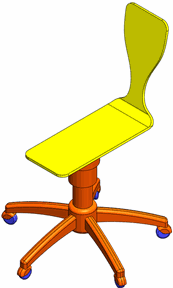When many thin solid parts are present in an assembly, you can save analysis time by converting them into sheet metal or surface bodies without compromising accuracy of results.
This lesson shows you two ways to convert a thin solid body, the seat of a chair assembly, into a body that meshes with shells: a) by converting the solid body into a sheet metal and b) by offsetting faces to create a surface body. You perform a static analysis and compare the results between the assembly with all solid bodies and the assembly with mixed bodies.

In this lesson, you learn how to:
- Convert a solid body into a sheet metal body
-
Create surface geometry from a solid by offsetting faces
- Define a bonded contact condition between non-touching faces of a surface and a solid
- Exclude redundant bodies from a Simulation study
- Compare results of different models